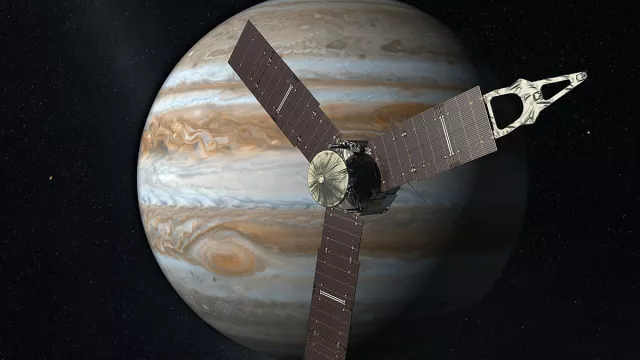The Juno spacecraft was developed by NASA to study Jupiter close up, analysing the planet’s atmospheric composition, deep structure and magnetic field to search for clues about its origin.
Key information
Key figures
- 3,625 kg: spacecraft mass
- 9 instruments
- 20.1 x 4.6 m: spacecraft dimensions
- 3 contributing French laboratories
Key milestones
- January 2021: NASA extends mission to September 2025
- June 2018: NASA extends mission to July 2021
- 5 July 2016: Juno arrives in orbit around Jupiter
- 9 October 2013: Earth gravity assist
- 5 August 2011: Juno launched by Atlas V 551
- 9 June 2005: NASA selects Juno mission for its New Frontiers programme
Project in brief
Juno is NASA’s second New Frontiers mission, succeeding New Horizons and preceding OSIRIS-REx. The spacecraft launched on 5 August 2011 and entered Jovian orbit on 5 July 2016. Initially scheduled to end in 2018, the mission was extended to 2022 and then again to 2025 for technical reasons. It will culminate with the spacecraft’s destruction as it plunges into the planet’s atmosphere for a closer look at its composition.
Juno has several special features. The first is that its highly eccentric orbit takes it over Jupiter’s poles with a perijove—its closest point to the planet—very close to the cloud tops (5,000 km). It’s also the first spacecraft capable of venturing so far from the Sun powered only by its solar panels: thanks to its more-efficient photovoltaic cells, it isn’t carrying a radioisotope thermal generator (RTG) previously used for such missions.
Juno is also spin-stabilized, meaning that it uses its own spin (2 rpm) to achieve gyroscopic stabilization.
In addition to its instrument payload, Juno is carrying JunoCam, a camera that has no specific science role but is acquiring remarkable pictures of the planet to engage the public.
As part of Europe’s close involvement in this U.S. mission, CNES helped the IRAP astrophysics and planetology research institute to build the JADE-E electron sensor for the JADE instrument. JADE is designed to detect energetic particles (electrons and ions) produced by Jupiter’s polar auroras, thus complementing Juno’s other instruments to study Jupiter’s magnetosphere.
The JIRAM instrument is another European contribution to the mission, led by Italy. JIRAM is an infrared imaging spectrometer probing the deep atmosphere down to 100 kilometres.
Several French research scientists and laboratories are also involved in studying science data from Juno.
CNES’s role
As part of Europe’s close involvement in this U.S. mission, CNES helped the IRAP astrophysics and planetology research institute to build the JADE-E electron sensor for the JADE instrument. JADE is designed to detect energetic particles (electrons and ions) produced by Jupiter’s polar auroras, thus complementing Juno’s other instruments to study Jupiter’s magnetosphere.
Contacts
Solar System Planets and Small Bodies subject matter expert
Francis Rocard
E-mail: francis.rocard at cnes.fr
Sun, Heliosphere & Magnetospheres (SHM) subject matter expert
Kader Amsif
E-mail: kader.amsif at cnes.fr


